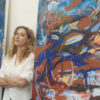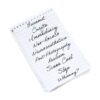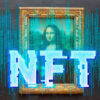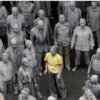هدا ظرباف در گالری آران
|احجام گلدار
| عنوان مسافران زمان
|افتتاحیه ۲۴ اردیبشت ماه
| آدرس: تهران، خیابان خردمند شمالی، کوچه دی، شماره ۱۲
| تلفن: ۸۸۸۲۹۰۸۷
ترکیب شده، تغییر شکل یافته و دست دوخته، دومین مجموعه مجسمه های هدا زرباف از خرده ریزهای مستعمل خانوادگی، لباسهای بازیافت شده، مبلمان قدیمی ، عروسکهای نرم و خرت و پرتهائی که در گشت و گذارش در تهران می یابد، ساخته شده اند
مجموعه ی” احجام گلدار، مسافران زمان “هویت خود را، هم در فرم و هم در معنا، از رابطه ی دوگانگی اقتباس می کند. زرباف از پارچه های قدیمی و بازیافتی، و همچنین تکنیک های فولکلور کوک زدن و تکه دوزی، بهره می برد، تا به صمیمتی قابل لمس دست پیدا کند. در ساخته های خود هنرمند، پیوندی بین معناهای متضاد برقرار می کند تا به حالت مطلوب برسد: بنجل و پربها، نرم و سخت، قدیمی و جدید. کوک هایی که همزمان کنترل شده و بی نظم هستند، متریال نرم را به استحکام مبلمان قدیمی وصل می کنند و مجسمه های فیگوراتیو بزرگی را پدید می آورند که برای هنرمندِ به خانه بازگشته، ابزاری هستند برای اتصال روایتهای گذشته و حال
در بازگشتش به ایران پس از سفری نه ساله به آمریکای شمالی، در مجموعه ی جدیدی که در تهران درست می شود، زرباف قصه های زندگی گذشته خود را جستجو می کند. او به کند و کاو در خاطرات کودکی، روابط جدید خانوادگی و همچنین روزمره گی های زندگی اش در تهران، می پردازد. تکه های به جا مانده نظیر لباسها و وسائل منزل خانواده اش ( که زمانی با انسانهای زندگی قبلی او در تهران در تماس مستقیم بوده اند)، با ترکیبهای جدید مجسمه هایش پیوند می خورند؛ و این تلاشی است برای برقرار ساختن رابطه با گذشته و یادآوری صمیمیتی از دست رف
زرباف روایت خود را با اضافه کردن و جاسازی رسانه های زمان – محوری همچون ویدئو، صدا و نور ، به مجسمه هایش، بعد دیگری می بخشد. در نامه ای به دوستی، هنرمند اظهار می کند که این روزها حس می کند که ما بیشتر مسافر زمان هستیم تا مکان. از همین روی، او پارچه های گلدار را در طول زمان به حرکت درمی آورد. برای برقراری ارتباط بیشتر با این گذرگاهها، بصورت استعاری، هنرمند وسائل دیگری را نیز در هم می آمیزد: چرخ های صنعتی زیر جعبه هائی که حامل عروسکها ی نرم هستند؛ و یا فرمهای نرمی که سیال گونه به دور مانیتور های قدیمی دوخته می شوند و همزمان موی انسان و یا فرم های قالب گرفته شده ی بدن را نمایان می کنند
این مجموعه، آسیب پذیری در کنار تحرک را به نمایش می گذارد، و همزمان مفاهیم جدید و قدیمی را پیش چشم مخاطب قرار می دهد. فرمهای نرمی که بارها با پارچه های گلدار ساخته می شوند از بقایای مغازه ی پارچه فروشی پدربزرگ هنرمند هستند؛ به همراه مبلمان قدیمی و عروسکهای رها شده، زرباف مسافران زمانی را به عرصه ظهور می آورد که از زمان خود فراتر می روند و مفهوم تعلق را به چالش می کشند
Hoda Zarbaf
The Floral Compositions, Travelers of Time
Opening on 13th May 2016 at Aaran Gallery
Composed, reshaped and hand-stitched, Hoda Zarbaf’s second sculptural series are made up of old family knick-knacks, recycled clothing, abandoned furniture pieces, stuffed dolls, and the varied artifacts she has gathered while strolling around Tehran.
Titled “Floral Compositions, Travelers of Time”, the sculptures borrow their identity, both in form and concept, from the unity of the dichotomies. Zarbaf has used pre-owned or vintage textiles–along with the traditional folk practice of stitching and patching–to bring a palpable level of intimacy to her work. In her making, the artist marries contrary concepts to achieve the optimum: giveaway and invaluable, pappy and concrete, old and new. Stitches that are both controlled and disorderly unify the soft materials to solid furnishings, creating large figurative sculptures that in a way reconnect the artist to the former and current narratives of her homecoming.
Following her return to Tehran from a nine-year journey in North America, Zarbaf in a new series—created in Tehran—explores the tales of her past life. During this time, she has rummaged through her childhood memories, new family anatomy, as well as solid Tehran daily routines. Abandoned pieces of clothing or old family house items (which have at some point been intimately in contact with the humans from her previous time in Tehran), are married into newly composed sculptures—reconnecting with the past and reminiscent of the lost intimacy.
Moreover, Zarbaf takes her narrative to a new dimension by embedding time-based media such as video, sound and lights in the sculptures. She expresses, in a letter to her friend about this journey, that she thinks these days we are more the travelers of time than of space. She, therefore, leads the so-called floral materials from the past and passes them through the time. To further communicate these passages, metaphorically, Zarbaf interweaves different mediums into each other to further: Industrial wheels carrying a box with stuffed dolls on them; or Soft oozing forms which are stitched around old monitors while exposing human hair or cast limbs.
The collection projects vulnerability while evoking motion—past and present. The soft forms that she has repeatedly created from the floral textiles are mostly remains of her grandfather’s fabric store. Together with the pieces of old furniture, and orphan dolls, Zarbaf has created time travelers that transcend their era and challenge the idea of belonging.








